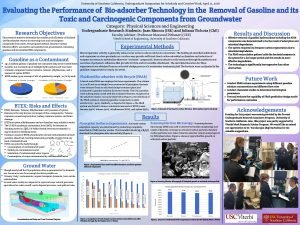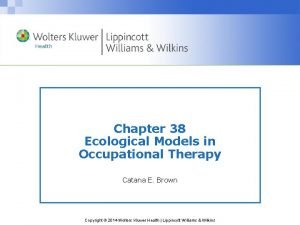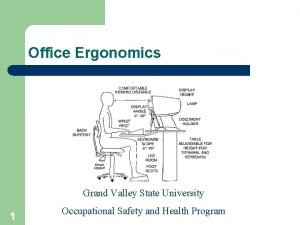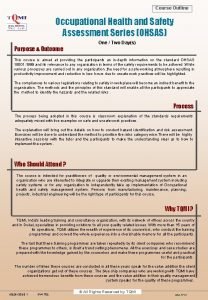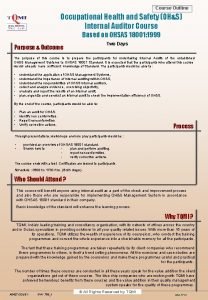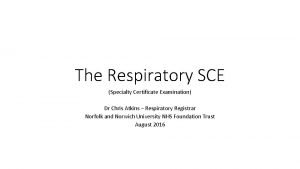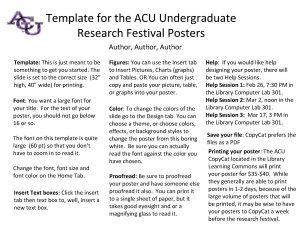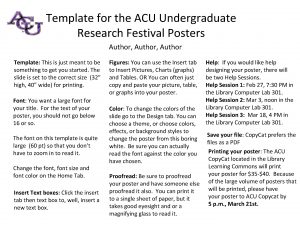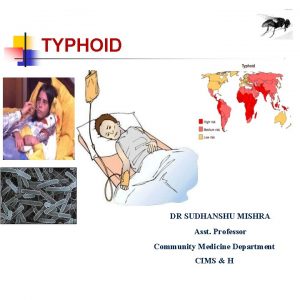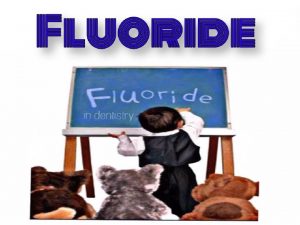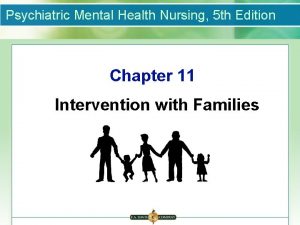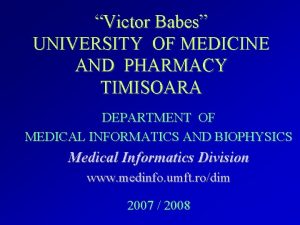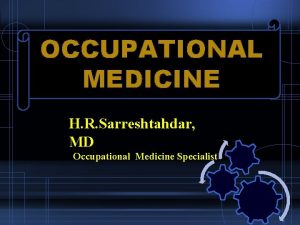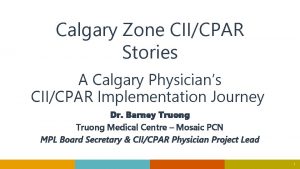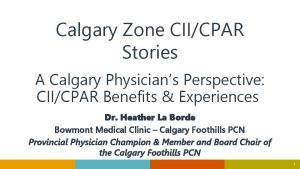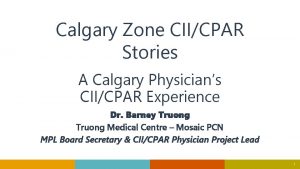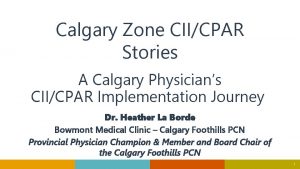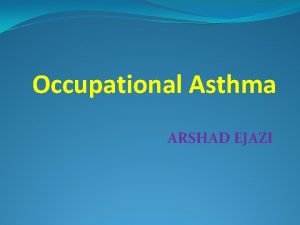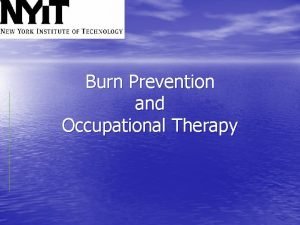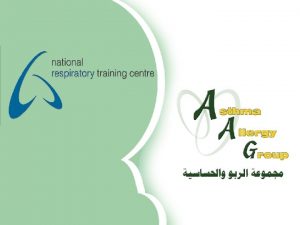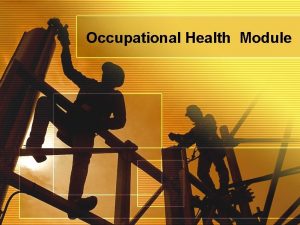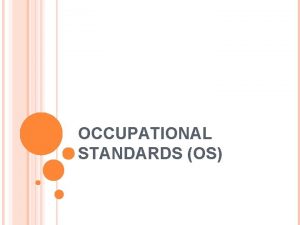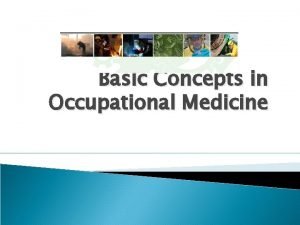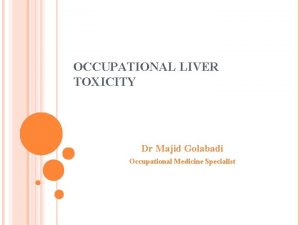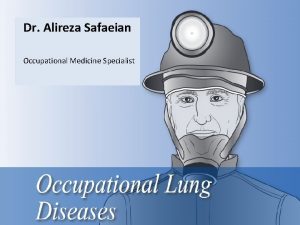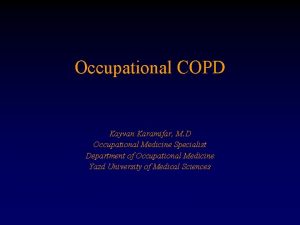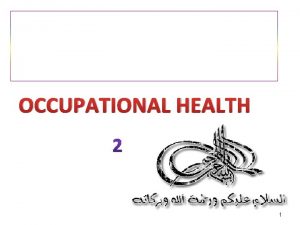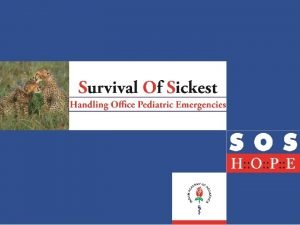University of Calgary Undergraduate Medicine RESPIRATORY COURSE OCCUPATIONAL










































































- Slides: 74

University of Calgary - Undergraduate Medicine RESPIRATORY COURSE OCCUPATIONAL LUNG DISEASE: CASE PRESENTATIONS Kenneth Corbet MD FRCPC Community Health Sciences

Inhalation of Air Contaminants: Diagnostic Approach 1. describe recent and remote inhalational exposures: smoke, chemicals, mineral dusts and organic/biological 2. assess symptoms, signs, chest radiograph, spirometry, and blood gases 3. identify the level(s) of the respiratory tract that are likely involved, and any systemic effects 4. consider occupational lung disease in your diagnosis (refer to Table in Core Document)

History In addition to a general medical history, ask about: • the patient’s respiratory symptoms • current and past exposures to air contaminants • the temporal relationship between exposure and symptoms • other persons with similar symptoms • the impact of symptoms on the patient’s activities

Physical Examination Examine the patient (inspection, percussion, auscultation, palpation) for key findings associated with respiratory diseases.

Investigations · chest radiograph · spirometry (FVC, FEV 1%) · arterial blood gases · · · • • lung volumes diffusion capacity peak flow monitoring methacholine challenge testing bronchoalveolar lavage (BAL)

Differential Diagnosis Based on the type of air contaminant and the level(s) of the respiratory tract involved, consider occupational causes in the diagnosis


Case Presentation #1 Acute Inhalational Exposure

Occupational Lung Disease: Case Presentation #1 Hank is a 36 year old man who presents to the Emergency department at 9 PM. He is usually quite healthy, but over the past few hours he has felt progressively ill, with occasional chills, myalgia, and cough. He has worked at local metal recycling smelter in the 'melting room' for the last two years. Ongoing problems with ventilation - smokes and fumes can get 'pretty thick' at times.

Occupational Lung Disease: Case Presentation #1 How would you describe the air contaminants? What level of the respiratory tract is involved? What are possible occupational diagnoses?

Occupational Lung Disease: Case Presentation #1 How would you describe the air contaminants? Smokes, fumes - possibly chemicals What level of the respiratory tract is involved? What are possible occupational diagnoses?

Occupational Lung Disease: Case Presentation #1 How would you describe the air contaminants? Smokes, fumes - possibly chemicals What level of the respiratory tract is involved? Cough can originate from all levels of the respiratory tract; note systemic symptoms What are possible occupational diagnoses?


Occupational Lung Disease: Case Presentation #1 Findings 1. 1 Physical Examination • • mild fever (38. 5 C) mild pharyngeal redness chest clear, no distress or tachypnea HR 90, no murmurs or bruits Investigations • mild increase in WCB • normal spirometry • normal blood gases

Chest Radiograph 1. 1 International Labour Organization


Inhalational Fevers Self-limited syndrome of mild fever, leukocytosis, myalgia; onset usually 4 -6 hours after exposure, resolves 24 -48 hours; no apparent sequelae in regards to lung pathology or function. Metal Fumes zinc, copper, manganese Organic Dusts grain dust, moldy silage Plastics Teflon (fluorinated) Endotoxins contaminated humidifiers

Occupational Lung Disease: Case Presentation #1 Findings 1. 2 Physical Examination • occasional wheezes, afebrile • scant phlegm, black specks, no blood Investigations • chest radiograph normal, normal WBC • blood gases - mild respiratory alkalosis • FVC 104% predicted; FEV 1 81% predicted; FEV 1/FVC = 62%

Occupational Lung Disease: Case Presentation #1 How would you describe the air contaminants? What level of the respiratory tract is involved? What are possible occupational diagnoses?

Occupational Lung Disease: Case Presentation #1 How would you describe the air contaminants? Smokes, fumes - possibly chemicals What level of the respiratory tract is involved? Wheezing and obstructive pattern on spirometry suggests small airway involvement What are possible occupational diagnoses?


Occupational Lung Disease: Case Presentation #1 - Findings 1. 2 Airways Injury - Reactive Airways Disease Symptoms occur with 24 hours after single, high intensity exposure to irritant gas, smoke, fume, or vapour Cough, wheeze, and dyspnea Spirometry may show small airway obstruction methacholine challenge + If airways reactivity and symptoms persist > 6 months = Reactive Airways Dysfunction Syndrome (RADS)

Occupational Lung Disease: Case Presentation #1 Findings 1. 3 Physical Examination • mild distress, tachypneic, tachycardic • scattered crackles, occasional wheezes Investigations • mild hypoxemia on ABG • mixed obstructive and restrictive pattern on spirometry

Chest Radiograph 1. 3 International Labour Organization

Occupational Lung Disease: Case Presentation #1 How would you describe the air contaminants? What level of the respiratory tract is involved? What are possible occupational diagnoses?

Occupational Lung Disease: Case Presentation #1 How would you describe the air contaminants? Smokes, fumes - possibly chemicals What level of the respiratory tract is involved? Chest x-ray changes suggest parenchymal involvement, can’t rule out small airways. What are possible occupational diagnoses?


Chemical Pneumonitis - ARDS • onset within hours (up to 36 hours) after exposure • progressive respiratory distress, hypoxemia, diffuse interstitial/air space changes on CXR • interstitial fibrosis, bronchiolitis obliterans or reactive airways disease may persist after initial recovery • high index of suspicion required based on intensity of exposure and nature of industrial process

Some agents that produce chemical pneumonitis: acrolein hydrogen sulfide cadmium nitrogen dioxide chlorine ozone fire smoke phosgene hydrogen chloride sulphur dioxide

Case Presentation # 2 Abnormal Chest Radiograph

International Labour Organization

Occupational Lung Disease: Case Presentation #3 Bill is a 65 -year-old retired accountant who presents for a periodic medical exam. He reports only slight dyspnea on exertion, no cough or sputum; he has never smoked. For each of a series of possible chest radiographs, what is a possible occupational cause, and what would you ask Bill on a more detailed history?

Chest Radiograph 2. 1 International Labour Organization

Asbestos Fiber Courtesy of Dr. Francis Green

Chest Radiograph 2. 2 International Labour Organization

Distribution of Irregular Opacities In Asbestosis International Labour Organization

INTERSTITIAL FIBROSIS - ASBESTOSIS Courtesy of Dr. Francis Green

ASBESTOSIS Courtesy of Dr. Francis Green


Chest Radiograph 2. 3 International Labour Organization

Courtesy of Dr. Francis Green

Particle Deposition Courtesy of Dr. Francis Green

Dust Nodule Courtesy of Dr. Francis Green

Distribution of Rounded Opacities In Silicosis International Labour Organization

Parenchymal Dust Deposition Courtesy of Dr. Francis Green


Progressive Massive Fibrosis Courtesy of Dr. Francis Green

Progressive Massive Fibrosis Courtesy of Dr. Francis Green

Courtesy of Dr. Francis Green

Courtesy of Dr. Francis Green

Courtesy of Dr. Francis Green

Courtesy of Dr. Francis Green

Courtesy of Dr. Francis Green

Courtesy of Dr. Francis Green

Courtesy of Dr. Francis Green

Courtesy of Dr. Francis Green

Courtesy of Dr. Francis Green

Courtesy of Dr. Francis Green

Courtesy of Dr. Francis Green

Courtesy of Dr. Francis Green

Courtesy of Dr. Francis Green

Courtesy of Dr. Francis Green

Courtesy of Dr. Francis Green

Courtesy of Dr. Francis Green

Courtesy of Dr. Francis Green

Courtesy of Dr. Francis Green

Courtesy of Dr. Francis Green

Courtesy of Dr. Francis Green

Courtesy of Dr. Francis Green

Courtesy of Dr. Francis Green

Courtesy of Dr. Francis Green

Courtesy of Dr. Francis Green

Courtesy of Dr. Francis Green

Courtesy of Dr. Francis Green
 Portland state university undergraduate tuition and fees
Portland state university undergraduate tuition and fees Acadia university undergraduate programs
Acadia university undergraduate programs University of southern california
University of southern california Temple university undergraduate bulletin
Temple university undergraduate bulletin University of calgary orientation
University of calgary orientation Ehp occupational therapy
Ehp occupational therapy Grand valley occupational medicine
Grand valley occupational medicine Conducting zone of the respiratory system function
Conducting zone of the respiratory system function Occupational health and safety course outline
Occupational health and safety course outline Occupational health and safety course outline
Occupational health and safety course outline Speciality certificate examination in respiratory medicine
Speciality certificate examination in respiratory medicine Occupational therapy cleveland state
Occupational therapy cleveland state Florida occupational therapy association
Florida occupational therapy association University of cumbria
University of cumbria Occupational health cardiff and vale
Occupational health cardiff and vale Cosmos meaninh
Cosmos meaninh Uci ics counselor
Uci ics counselor Seoul university acceptance rate
Seoul university acceptance rate Definition of undergraduate student
Definition of undergraduate student Undergraduate research conference nyu
Undergraduate research conference nyu Difference between postgraduate and undergraduate
Difference between postgraduate and undergraduate Difference between postgraduate and undergraduate
Difference between postgraduate and undergraduate Cornell neuroscience undergraduate major
Cornell neuroscience undergraduate major Los angeles city college undergraduate enrollment
Los angeles city college undergraduate enrollment Dean of undergraduate studies fsu
Dean of undergraduate studies fsu Csub orientation
Csub orientation What is an undergraduate degree
What is an undergraduate degree Acu undergraduate research festival
Acu undergraduate research festival Acu copycat
Acu copycat Usc neuroscience major
Usc neuroscience major Michael flavin
Michael flavin Unb undergraduate calendar
Unb undergraduate calendar Ncsu undergraduate research symposium
Ncsu undergraduate research symposium Typhoid medicine course
Typhoid medicine course Half brick wall in stretcher bond
Half brick wall in stretcher bond Course number and title
Course number and title Chaine parallèle muscle
Chaine parallèle muscle Calgary topography
Calgary topography Rainwater harvesting calgary
Rainwater harvesting calgary Metta clinic calgary
Metta clinic calgary Prime funds calgary
Prime funds calgary Blue cart calgary
Blue cart calgary Adlc calgary
Adlc calgary Prostaid calgary
Prostaid calgary Fourosis
Fourosis Durma canada
Durma canada Chestermere public works
Chestermere public works Ihm sisters calgary
Ihm sisters calgary Calgary dsaek
Calgary dsaek Engage calgary
Engage calgary Fair trade calgary
Fair trade calgary Northside church of christ calgary
Northside church of christ calgary 10655 southport road sw
10655 southport road sw Asthenozoospermia treatment
Asthenozoospermia treatment Chapter 11 psychiatric mental health nursin
Chapter 11 psychiatric mental health nursin Lap band calgary
Lap band calgary Calgary heritage authority
Calgary heritage authority Emsl calgary
Emsl calgary Stott and davis model example
Stott and davis model example Figure skating calgary
Figure skating calgary Aicp calgary
Aicp calgary Adlc calgary
Adlc calgary Maxview homes
Maxview homes Calgary-cambridge observation guide
Calgary-cambridge observation guide Power platform calgary
Power platform calgary John keenan calgary
John keenan calgary Calgary flames sponsors
Calgary flames sponsors Havis console
Havis console Organic shapes
Organic shapes Cbc.c/anews
Cbc.c/anews Healthy hunger
Healthy hunger St thomas united church calgary
St thomas united church calgary Dr siauw calgary
Dr siauw calgary Victor babeş university of medicine and pharmacy
Victor babeş university of medicine and pharmacy Hubert kairuki memorial university faculty of medicine
Hubert kairuki memorial university faculty of medicine


